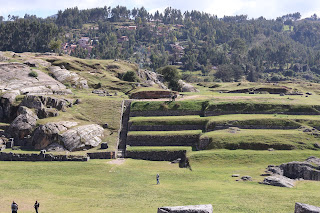Sacsayhuamán, often spelled Sacsahuaman or Saqsaywaman (from Quechua
Saqsaywaman (pukara) '(fortress) of the royal falcon or hawk'),
is a citadel on the northern outskirts of the city of Cusco, Peru, the
historic capital of the Inca Empire.
The complex was built by the Incas in the 15th century, particularly under
Sapa Inca Pachacuti and his successors.
Dry stone walls constructed of huge stones were built on the site, with the
workers carefully cutting the boulders to fit them together tightly without
mortar.
|
Entering Sacsayhuaman
Sacsayhuaman is located on a steep hill overlooking the city of Cuzco.
|
|
Sacsayhuaman Plan
Plan Legend:
- Parking lot
- Stepped walls
- Main door
- Paucamarca
- Sallacmarca
- Muyumarca
- Large plaza
- Inca Throne
- Qocha Chincanas
- Colcas or warehouses
|
|
Panorama of the large plaza
The large plaza (Plan No. 7), capable of holding thousands of people,
was designed for communal ceremonial activities.
|
|
Panorama of the Inca Throne
The Inca Throne (Plan No. 8), located next to the fortress, consisted of
a large rock carved and polished on several levels, from where the
sovereign presided over festivals, celebrations, parades and gave
orders.
|
|
Panorama of the fortress
It is thought that it corresponded to a military fortress, where
warriors were trained.
-
There are doubts about it, since, according to its architecture, it
could have had a religious purpose and been built as a great temple to
the Sun God.
-
However, during the time of the conquest, it showed its effectiveness
as a fortress to defend the city.
|
|
Ceque system
The ceque system was a series of ritual pathways leading outward from
Cusco into the rest of the Inca Empire.
-
The empire was divided into four sections called suyus. In fact, the
local name for the empire was "Tawantinsuyu," meaning "four parts
together."
-
Cusco, the capital, was the center and meeting point of these four
sections, which converged at Qurikancha, the temple of the sun.
-
A total of 41 or 42 known pathways radiated out from the Qurikancha or
sun temple in Cusco, leading to shrines or wak'as of religious and
ceremonial significance.
|
|
Main entrance to the fortress
The main entrance (Plan No. 3) to the fortress is located in the center
of the triple wall (Plan No. 2).
-
The best-known zone of Sacsayhuamán includes its great plaza and its
adjacent three massive terrace walls.
-
The stones used in the construction of these terraces are among the
largest used in any building in pre-Hispanic America.
-
They display a precision of cutting and fitting that is unmatched in
the Americas. The stones are so closely spaced that a single piece of
paper will not fit between many of the stones. This precision,
combined with the rounded corners of the blocks, the variety of their
interlocking shapes, and the way the walls lean inward, is thought to
have helped the ruins survive devastating earthquakes in Cuzco.
-
The longest of the three walls is about 400 meters (1312 ft). They are
about 6 meters (20 ft) tall. The estimated volume of stone is over
6,000 cubic meters (211,888 cubic feet).
-
Estimates for the weight of the largest limestone block vary from 128
tonnes to almost 200 tonnes. These stones were moved an estimated 35
km (22 miles) from Rumicolca.
|
|
The Inca Throne (Plan No. 8) seen from the top of the fortress.
|
|
Crossing towards the viewpoint
|
|
Panorama of the city of Cuzco
On the left side of the panorama we can see the site of the Temple of
Coricancha.
|
|
Panorama of the religious sector
The religious sector is made up of Paucamarca (Plan No. 4), Sallacmarca
(Plan No. 5) and Muyumarca (Plan No. 6).
|
|
Panorama of Sallacmarca (Plan No. 5)
The fortress was the setting where the Incas worshiped the sun in this
temple for religious ceremonies.
-
It is thought that tens of thousands of people mobilized on special
festivals and made offerings and certain types of pilgrimages.
|
|
Panorama of Muyumarca (Plan No. 6)
Muyucmarca (Quechua: round place) was one of the three towers on the
upper part of the Inca temple of Sacsayhuaman.
-
The site is of historical importance because from here, in 1536, the
Inca captain and noble Cahuide led a thousand Cusco soldiers for
several days, without water, without food and with little ammunition
of stones and arrows, the last defense of Sacsayhuaman against a great
allied army of Spanish and indigenous people, and where, after being
left alone and seeing how numerous enemies surrounded him, he threw
himself from the top of this tower to avoid falling into the hands of
the Spanish.
|
|
Sun Gate (Intipunku)
The Sun Gate (Intipunku) is located at the eastern end of Sacsayhuaman's
triple wall.
|
See also
Source
Location






































































